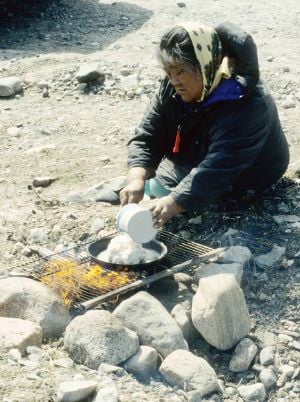Bannock (food)
Bannock is a bread the same thickness as a scone. It is a form of flat bread, baked on a griddle. Generally made of oatmeal, it takes the form of a large oatcake. However, this meaning is not universal and some Scots use the term to refer to a wheat flour cake similar to a large thin scone.
The oldest and certainly the most famous of all bannocks is The Selkirk Bannock, The first bannock is said to have been made by a Robbie Douglas who opened his shop in Selkirk in 1859. When Queen Victoria visited Sir Walter Scott's granddaughter at Abbotsford she is said to have refused all else with her tea save a slice of the cake - ensuring that the bannock's reputation was enshrined forever. Robbie Burns also mentions the bannock in his Epistle to James Tennant of Glenconner, in reference to Alexander Tennant.
Native Americans and particularly Métis, in western Canada and the northern Great Plains in the United States, adopted bannock in their own cuisine over the 18th and 19th centuries, most likely from Scottish fur traders. This simple source of carbohydrates was easy to make on the trail and neatly complemented high protein trail foods like pemmican. As a result, even today many Métis and aboriginal western Canadians routinely prepare this dish. In western Canada, bannock is more closely associated with native and Métis culture than with its Scottish roots.
Native and Métis bannock is generally prepared with white or whole wheat flour, baking powder and water, which are combined and kneaded (possibly with spices, dried fruits or other flavouring agents added) then fried in rendered fat, vegetable oil, or shortening.
Bannock is also popular with hikers/canoeists. A premix of flour, baking soda and any assortment of dried fruits, oatmeal, etc. can be carried in plastic bags.
ReferencesISBN links support NWE through referral fees
- Maxwell, Marion. 1997. A Little Book of Scottish Baking. Pelican Publishing Company. ISBN 978-1565542907
External links
- Welsh Bannock Traditions
- All about Canadian aboriginal bannock
- Cooking Bannock - Bushcraft Style
- Traditional Scottish Recipes - Selkirk Bannock
- Bannocks recipe
- Bannock 101
- Bannock
Credits
New World Encyclopedia writers and editors rewrote and completed the Wikipedia article in accordance with New World Encyclopedia standards. This article abides by terms of the Creative Commons CC-by-sa 3.0 License (CC-by-sa), which may be used and disseminated with proper attribution. Credit is due under the terms of this license that can reference both the New World Encyclopedia contributors and the selfless volunteer contributors of the Wikimedia Foundation. To cite this article click here for a list of acceptable citing formats.The history of earlier contributions by wikipedians is accessible to researchers here:
The history of this article since it was imported to New World Encyclopedia:
Note: Some restrictions may apply to use of individual images which are separately licensed.

